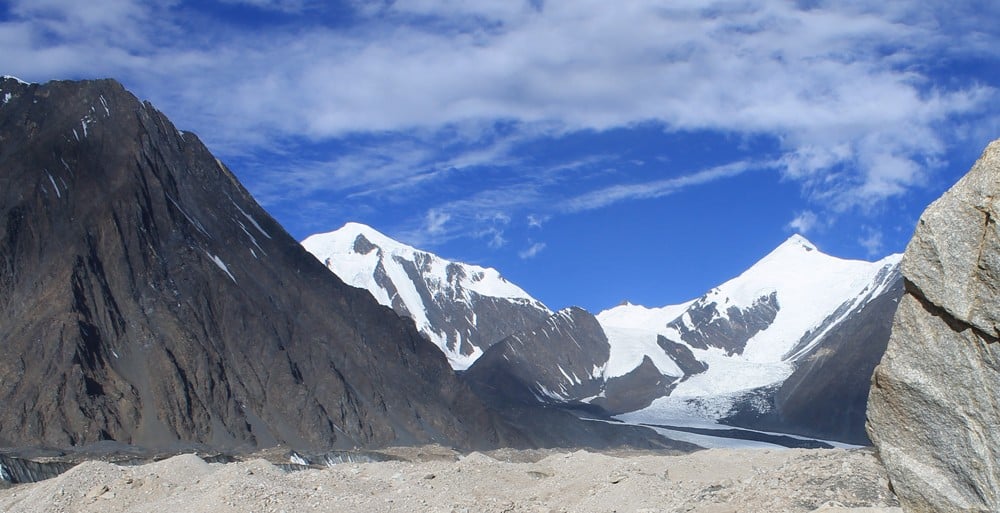
A brave climb up to the Babu Camp is worth the effort, for the view that awaits is simply awesome

Deep beneath the frigid tops of Seven Thousanders, lays a world, devoid of life in a literal sense, but nonetheless living in its own way. It is a place where live immense glaciers, gushing rivers, twisting boulders and of course, hurricane force winds. This place is cold, this place is lonely, and this place is hidden.
And, it is this place where I’ve been.
Northern Pakistan is blessed with the three mightiest mountain ranges in the world, namely, Himalayas, Karakoram and Hindu Kush.
Hindu Kush is mostly known for its highest mountain, Tirich Mir, which, standing at 7708m is the world’s 33rd highest mountain and Pakistan’s 12th highest. It is a mountain of immense magnitude, peaking nearly 10,000 feet above base camps from all sides that have approaches for climbing. Visible from Chitral bazaar, this mountain hardly warrants any description.
Despite such magnificence, I wanted to know not Tirich Mir, but rather Noshaq and Istoro Nal. Noshaq at 7492m is the second highest mountain of the Hindu Kush and the 52nd highest mountain in the world. Istoro Nal, at 7403m is the third highest mountain of the Hindu Kush and the 68th highest in the world. Despite these credentials, ask anybody in Chitral and they won’t know the facts. All the charm is reserved for Tirich Mir!
And so Noshaq and Istoro Nal were our targets. We, a company of four, made our way to Babu Camp at the junction of the great Tirich and Noshaq glaciers. Getting there wasn’t the easiest job, for it took us two and a half days of tremendous effort.
The ordeal began at Shagrom, wherefrom the road or mule track to be precise, led to Atak, a summer pasture slightly off the terminal moraine of the Lower Tirich Glacier. After a whole day of strenuous hiking, we reached the moraine, to discover that the glacier was still half an hour away. Being dusk already, the first sign of seemingly clean water warranted a stopover -- and here we pitched our tents.
Nights in this craggy landscape are no sleepovers in heaven. The chill in the wind becomes unbearable as soon as the sun sets, with the night becoming progressively windier up by midnight. The sound of falling rocks or breaking glaciers wakes one up from an already weak sleep, fearing disaster as these sounds grow closer with every passing moment.
To put it simply, these are slow, cold, and harsh nights with a chilling loneliness written all over them.
The appetite is a natural victim of the long hours of fatigue and the chilly waters one drinks, with the desire to eat lessening every day. Glacial melt water can lead to stomach aches, and must be drunk with care; a lesson I learnt the hard way.
It is the will to be where hardly anyone dares that propels you. It pushes you to exert yourself, test your own strength and perseverance.
The first night was sombre. The second was worse. Having passed a crevassed glacier and loose boulders tilting at the slightest exertion of force, and a punishing climb of 2500 feet altitude at heights that already take a toll on your body for want of oxygen, I reached camp over half an hour later than the rest of the party.
That night all I could think about was an easy way back and out. But that was not to be. We had already trekked some 25 kilometres in the last two days, and I had to cross the same path on the way back.
As the pills I had eaten for a shivering cold took effect past midnight, my thoughts were coherent again. I had seen Istoro Nal the past day, with its dark chocolate coloured icy cliffs peaking in the North, dominating the northern landscape. But was it enough? One doesn’t get to come here everyday, and it would be pointless coming if I went back without sneaking a peek at Noshaq, the world’s western-most Seven Thousander, and that would not be possible until I reached Babu Camp (15,706 feet above sea level).
The next morning was pretty much eventless, except that the sky was bright, the icy peaks were shining exquisitely with clouds gathering below us. Already at 14,700 feet altitude, storm clouds were unpredictable, but if they came, it would snow, we knew for sure.
Wasting time wasn’t an option, and the final push had to be made.
Jumping over boulders and trekking rocky inclines, eventually we made it to Babu Camp in three hours. Here I stood, atop the last rock that my aching muscles allowed me to scale, looking straight at Noshaq in the distance -- between me and Noshaq lay a heavily fractured glacier. If there was a pictorial description to awesomeness, this had to be it.
Three of the highest mountains of the Hindu Kush, interspersed between veins of milky white glaciers bordered by dark brown fringes of loose boulders, with the occasional cloud breaking the blue sheen of the sky. This looked like heaven, but set in hell!
Due to its close resemblance to Concordia, the confluence of glacial beds of the Karakoram, this valley is known among locals as the Tirich Concordia. Few have heard of it, even fewer know of it, and hardly anyone has been there. I can now be a proud soul, for having been to and through Tirich Concordia!